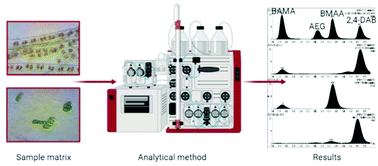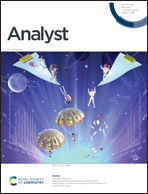A systematic review of analytical methods for the detection and quantification of β-N-methylamino-l-alanine (BMAA)†
Abstract
Neurodegenerative diseases are influenced by environmental factors such as exposure to toxins including the cyanotoxin β-N-methylamino-L-alanine (BMAA) that can bioaccumulate in common food sources such as fish, mussels and crabs. Accurate and precise analytical methods are needed to detect and quantify BMAA to minimize human health risks. The objective of this review is to provide a comprehensive overview of the methods used for BMAA analysis from 2003 to 2019 and to evaluate the reported performance characteristics for each method to determine the consensus data for each analytical approach and different sample matrices. Detailed searches of the database Web of Science™ (WoS) were performed between August 21st, 2018 and April 5th, 2019. Eligible studies included analytical methods for the detection and quantification of BMAA in cyanobacteria and bioaccumulated BMAA in higher trophic levels, in phytoplankton and zooplankton and in human tissues and fluids. This systematic review has limitations in that only the English language literature is included and it did not include standard operating protocols nor any method validation data that have not been made public. We identified 148 eligible studies, of which a positive result for BMAA in one or more samples analyzed was reported in 84% (125 out of 148) of total studies, 57% of HILIC studies, 92% of RPLC studies and 71% of other studies. The largest discrepancy between different methods arose from the analysis of cyanobacteria samples, where BMAA was detected in 95% of RPLC studies but only in 25% of HILIC studies. Without sufficient published validation of each method's performance characteristics, it is difficult to establish each method as fit for purpose for each sample matrix. The importance of establishing methods as appropriate for their intended use is evidenced by the inconsistent reporting of BMAA across environmental samples, despite its prevalence in diverse ecosystems and food webs.



 Please wait while we load your content...
Please wait while we load your content...